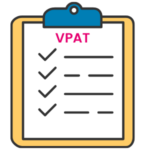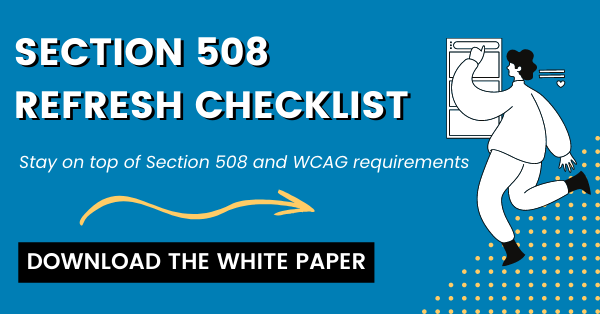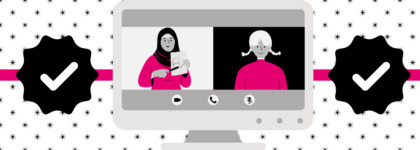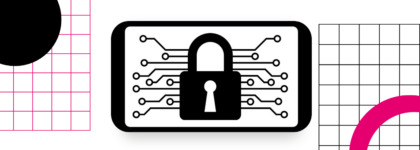Our New VPAT and Commitment to Internal Accessibility
Updated: August 30, 2021
As a company built around accessibility, we’re constantly looking for ways to improve the user experience of our products, platforms, and systems. For us, accessibility is both an external and internal commitment. We not only want to offer the highest quality accessibility solutions, but we also want to build an inclusive company culture and ensure customers with disabilities can use our services with ease.
These commitments might sound simple, but in reality, they require time, effort, and company-wide collaboration. Two years ago, we began a significant push to improve our internal accessibility through company culture shifts and updates to our account system. We updated our account system with three goals in mind: code maintainability, user experience, and accessibility. Since designing for accessibility often makes a better user experience for all, these goals were intertwined.
Check if your website is up to Section 508 standards
We often write about baking accessibility into websites, but we were guilty of building our original account system without being fully accessible to all customers. Rather than patch up inaccessible designs and code, we wanted to fix the problems and implement access from the beginning.
To ensure we created our account system with accessibility baked in, we started our code from scratch and worked with a third-party vendor to issue a Voluntary Product Accessibility Template (VPAT™) and conduct an accessibility audit in accordance with the Web Content Accessibility Guidelines (WCAG) 2.1 (Levels A, AA).
We’re excited and proud to continue our journey of making accessibility a company-wide initiative. Read on to learn more about our new VPAT and commitment to internal accessibility.
What is a VPAT?
A Voluntary Product Accessibility Template (VPAT™) is a document that evaluates how accessible a product is according to Section 508 of the U.S. Rehabilitation Act of 1973, as amended.
VPATs help customers determine the accessibility of information and communication technology products such as software, hardware, electronic content, and support documentation when evaluating potential vendors. A VPAT details all aspects of the Section 508 requirements and how a product supports each criterion.
For a bit of background, the U.S. Access Board issued a final rule in 2017 that refreshed Section 508 in response to technological innovations. The update integrated Section 508 requirements with other guidelines such as WCAG 2.0 Level AA success criteria, which means our VPAT encompasses both Section 508 and the relevant WCAG standards.
Though companies can opt to produce their own VPATs, a third-party vendor is often preferred for neutrality. We partnered with TPGi, a solutions provider that supports all phases of accessibility, to run digital accessibility testing on our account system and complete our VPAT.
Stay on top of Section 508 refresh requirements – download the checklist ✅
What did the process entail?
It’s no secret that accessibility requires coordination. Our account system update was an immensely collaborative effort—we needed people at all stages, on all teams, thinking about accessibility.
Namely, our design, product, development, and support teams were integral. At the beginning of the process, our design team recruited existing customers as participants for user interviews. The participants came from a diverse range of backgrounds, abilities, and experiences. To address accessibility needs, we reached out to a variety of screen reader and assistive technology users, who informed key user flows and customer actions in our account system.
In the process, our design team asked themselves questions such as:
- How do we want users to experience our system?
- Can someone navigate our system using only a keyboard?
- If someone is colorblind or uses a screen reader, how should they experience our system?
- How can we accommodate a diverse range of users who rely on different assistive technologies?
- How can we redesign reusable components to ensure future features and pages are accessible?
The answers to these questions helped guide our product team, who could vet whether designs would work in the ways we expected. Ideas bounced back and forth between product and design teams, and the development team figured out how to accomplish what product and design had set forth.
At each step, our teams integrated accessibility best practices and held dedicated accessibility sprints. Throughout the process, we conducted extensive testing with our support team before TPGi’s accessibility audit. Since each reassessment for our VPAT cost money, it was in our best interest to test early and often.
With design, product, development, and support teams involved in the account system update and marketing and sales teams involved in communicating results to customers, this was truly a company-wide initiative.
Wondering if your website is up to standard? Download our Section 508 checklist
Implementing access from the beginning
When we talk about implementing access from the beginning of the product development process, it’s helpful to use analogies to the physical world.
Consider a building designed to be accessible. There is an accessible ramp that leads to the front entrance and fits with the building’s design. The ramp is both practical and aesthetically pleasing, and it is used by disabled and nondisabled people alike.
In contrast, consider a building with only stairs leading to the front entrance. The accessible entrance is in the back of the building, where there is an ad-hoc ramp tacked onto the only door wide enough to accommodate wheelchair users. The accessible entrance is hard to find, looks out of place, is less useful, and alienates people. The tacked-on solution is neither good practice for business nor fair for people with disabilities.
Digital accessibility works similarly. Quick fixes and tacked-on features for inaccessible code will not correct the issue’s source and often lead to future problems and expenses. Here are some reasons why companies should implement accessibility from the beginning of the design process:
- Avoid “tacked-on” accessibility features and the problems they can create. While quick fixes might buy you some time, they will not solve accessibility problems. In some instances, they can even cause more problems for disabled users. As Lainey Feingold writes in her blog, tacked-on features “do not focus on the needs of people with disabilities to participate in the digital world. And they do not involve disabled people in creating the accessible technology and content they need. Instead, they leave people with disabilities out of the equation and ignore well documented evidence that installing one line of code does not eliminate barriers to digital inclusion.” By implementing access early and often, you can avoid future problems associated with tacked-on features.
- Design for a broad user base from the start. Did you know 71% of people with disabilities leave a website immediately if it’s not accessible? This statistic is amplified by the fact that in the UK, disabled people and their household members have £274 billion (~$383 billion) in spending power, and businesses lose out on an estimated £24 billion (~$34 billion) per year by ignoring their needs. By designing your site or product for the broadest possible user base from the start, you ensure all people can access your products and become potential customers—rather than using a competitor just because their website is accessible.
- Avoid potential lawsuits. When companies ignore the needs of disabled people, they become vulnerable to lawsuits. In 2020, digital accessibility lawsuits increased by 23%, according to a report from UsableNet. By implementing access from the beginning, companies can avoid accessibility lawsuits down the road.
- Decrease costs and time associated with addressing access barriers in the future. When companies incorporate accessibility into the entire design process, they can account for costs and implement best practices with ease. With consistent testing, bugs are caught early and solved in the development process, providing no inconvenience to users. In contrast, when accessibility issues arise later, users might be affected, additional costs accrue to find solutions, and teams need to spend extra time to solve preventable problems.
Focusing on the journey, not the destination
As accessibility advocates often like to say, access is a journey, not a destination. We must constantly strive for greater accessibility and inclusion with the knowledge that there is always more to do because access is never finished. Our new VPAT is one step of many in the right direction. As part of our roadmap for 2021, we are continuing to make our online platform more accessible and push for a more inclusive, equitable company culture.
At 3Play Media, we understand what it’s like to implement access in stages and have to go back and fix inaccessible products. While we have a long way to go, we are committed to creating a more accessible company and world.
We welcome any feedback at [email protected].
Want to help your organization stay on top of Section 508 and WCAG requirements? Check out our white paper to learn more.
Further Reading

Subscribe to the Blog Digest
Sign up to receive our blog digest and other information on this topic. You can unsubscribe anytime.
By subscribing you agree to our privacy policy.









